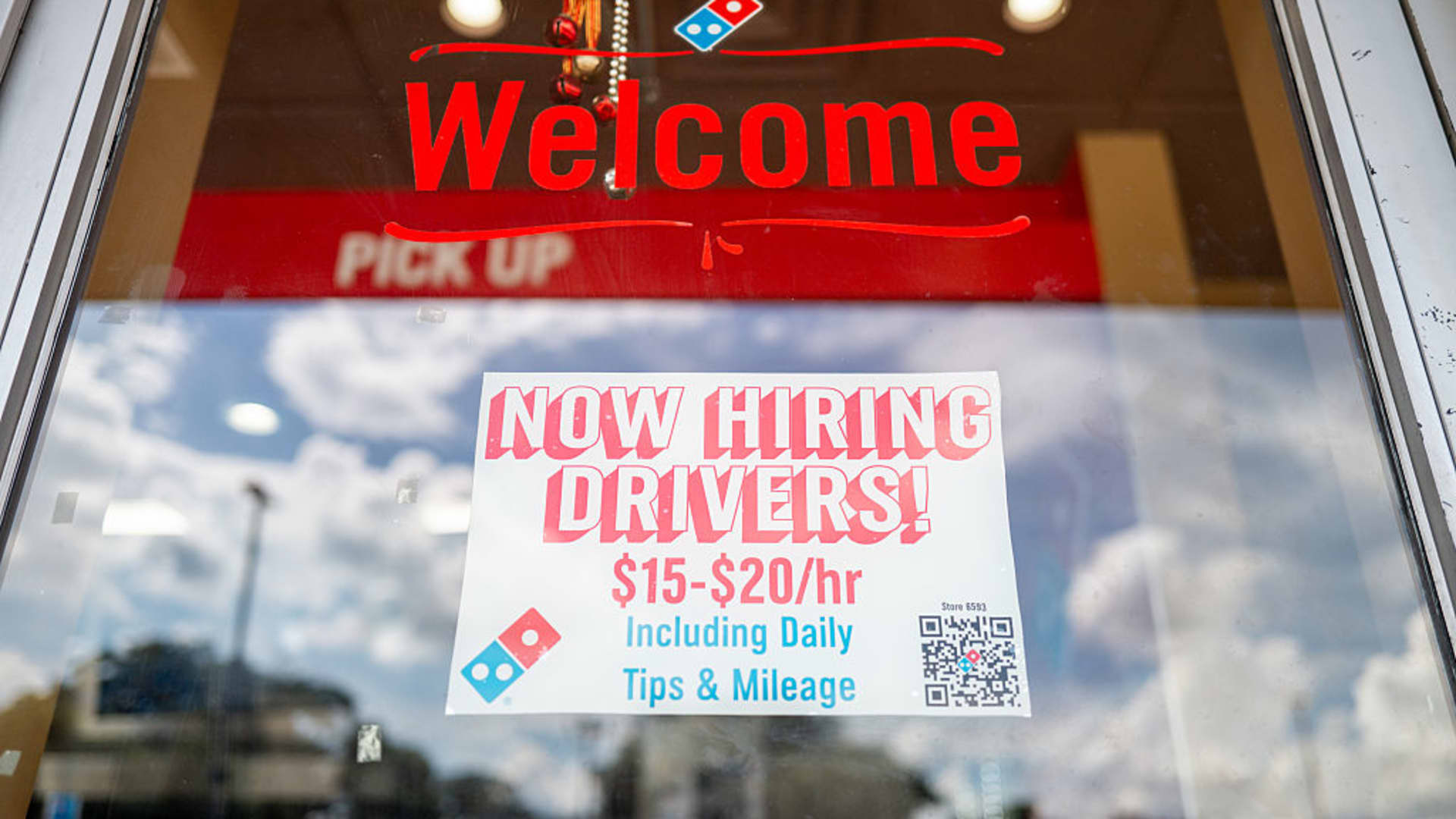Jobs data and policy updates will take center stage in the week ahead. Coming off a record-breaking week for the market , here’s a closer look at what we’ll be looking for in the holiday-shortened stretch of trading. 1. Jobs, jobs, jobs: The labor market will command center stage over the next four trading days. It has been losing steam, but not fallen apart. Recurring filings for unemployment insurance, known as continuing claims, is one indicator of the softening. Those totaled 1.97 million in the week ending June 14, their highest level since November 2021, and have been trending higher in recent weeks. Investors are keeping a close eye on jobs data amid questions about the health of the U.S. economy and the implications for Federal Reserve policy. For his part, Fed Chair Jerome Powell said during congressional testimony last week that he believed the U.S. labor market “is strong,” but added that if it were to weaken, “then that would argue for cutting rates sooner.” Despite President Donald Trump’s pressuring Powell to cut rates, the Fed has left policy unchanged as it awaits more clarity on the inflationary impact of Trump’s tariffs. On Friday, the Fed’s preferred inflation gauge for May came in slightly hotter than expected on a core basis , which excludes volatile food and energy prices. This week’s jobs data gets started Tuesday morning with the Job Openings and Labor Turnover Survey for the month of May. The so-called JOLTS report gauges the amount of slack in the labor market, offering clues on the strength of the economy and potential wage inflation. If the amount of job openings far exceeds the number of available work, then job-seekers generally are in a better position to demand higher wages. Economists expect there to have been 7.3 million openings, down from 7.4 million in April, according to Dow Jones. On Wednesday, payroll processing firm ADP will release its monthly report on private job creation, with expectations for 120,000 additions, according to Dow Jones. The release usually serves as an appetizer of sorts for the U.S. government’s official nonfarm payrolls report later in the week, though it’s not a direct read-through. As we saw with the May reports, ADP came in much weaker than expected, stoking concern among investors about what the government jobs data would show. It turned out to be slightly above muted estimates. The point is, the ADP report can be market-moving for the trader crowd, but it needs to be considered in the proper context and treated as just one data point in our larger understanding of where the labor market stands. The nonfarm payrolls report comes to us a day earlier than usual this week, given the market is closed Friday for the Fourth of July. The consensus forecast is that the U.S. economy added 115,000 jobs in June, which would be a deceleration from 139,000 in May, according to Dow Jones. The unemployment rate is expected to creep up to 4.3% The market also will keep an eye on the level of revisions to past reports. While a common occurrence, those updates put the latest jobs figures into better context. For example, alongside the May report, the April and March reports were revised lower by a combined 95,000. Also due out Thursday is the weekly initial jobless claims report, which is an especially valuable data point for investors in moments of labor-market uncertainty thanks to its frequency. We get it each week rather than needing to wait a month for nonfarm payrolls. To be sure, it is important to watch the trend in jobless claims — both first-time filings and continuing claims — instead of putting a lot of stock into one given week. As mentioned, continuing claims have been creeping up, a sign that people are having a harder time getting rehired after being let go, so we’ll be closely watching that line item in Thursday’s release. In the past two weeks, though, first-time filings have declined from the 250,000 level seen in early June. They stood at 246,000 in the week ended June 14 and 236,000 in the week ended June 21. Economists expect the streak to come to an end, with a consensus of 240,000 for Thursday’s release, according to Dow Jones. 2. Policy updates: In a week that’s quiet on the earnings front, we’ll be keeping an eye out for any updates out of the White House on trade talks with other countries. We started to hear a few things on this late last week, beginning with Press Secretary Karoline Leavitt saying the July 8 and 9 deadlines for Trump’s reciprocal tariffs to go back into effect are “not critical ,” adding that Trump could extend the deadlines as negotiations play out. That seems like a plausible outcome, but unpredictability is one of Trump’s hallmarks. The deal framework that the U.S. and China agreed to in Geneva last month also has been finalized, Commerce Secretary Howard Lutnick said Thursday evening. Then on Friday, Scott Bessent said on Fox Business that the Trump administration hopes to have deals with the country’s most important trade partners “wrapped up by Labor Day,” which gives credence to the idea that the July deadlines could be pushed out. Speaking at the White House on Friday, Trump said, “We’ve made a deal with probably four or five different countries,” but it’s unclear which nations he’s referring to. Other than China, the U.S. has thus far only announced an agreement with the U.K. On the negative side, Trump ramped up his rhetoric against Canada on Friday, saying he was ending trade talks with America’s northern neighbor over its digital services tax on U.S. tech firms. The other Washington policy story to watch in the week ahead concerns the Republicans’ tax and spending bill working its way through Congress. Trump had previously set July 4 as the deadline for its passage, but he said Friday it is “not the end all.” He added, “But we’d like to get it done by that time, if possible.” On Saturday night, the Senate narrowly passed a procedural vote on the legislation, officially kicking of the debate process. Week ahead Monday, June 30 Chicago Purchasing Managers’ Index at 9:45 a.m. ET Dallas Fed Index at 10:30 a.m. ET After the bell: Progress Software (PRGS) Tuesday, July 1 ISM Manufacturing PMI at 10 a.m. ET Job Openings and Labor Turnover Survey at 10 a.m. ET Census Bureau’s construction spending report at 10 a.m. ET Before the bell: MSC Industrial Direct (MSM) After the bell: Constellation Brands (STZ) Wednesday, July 2 ADP employment survey at 8:15 a.m. ET Before the bell: UniFirst (UNF) Thursday, July 3 Initial jobless claims at 8:30 a.m. ET Nonfarm payrolls report at 8:30 a.m. ET Trade balance at 8:30 a.m. ET ISM Services PMI at 10 a.m. ET Friday, July 4 U.S. market closed for Independence Day (See here for a full list of the stocks in Jim Cramer’s Charitable Trust.) As a subscriber to the CNBC Investing Club with Jim Cramer, you will receive a trade alert before Jim makes a trade. Jim waits 45 minutes after sending a trade alert before buying or selling a stock in his charitable trust’s portfolio. If Jim has talked about a stock on CNBC TV, he waits 72 hours after issuing the trade alert before executing the trade. THE ABOVE INVESTING CLUB INFORMATION IS SUBJECT TO OUR TERMS AND CONDITIONS AND PRIVACY POLICY , TOGETHER WITH OUR DISCLAIMER . NO FIDUCIARY OBLIGATION OR DUTY EXISTS, OR IS CREATED, BY VIRTUE OF YOUR RECEIPT OF ANY INFORMATION PROVIDED IN CONNECTION WITH THE INVESTING CLUB. NO SPECIFIC OUTCOME OR PROFIT IS GUARANTEED.





